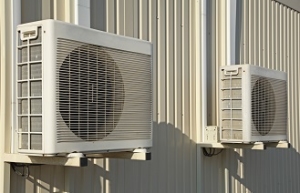
Mini-Split Heat Pumps
What it is:
Mini-Split heat pumps are heating and cooling units that have a compressor sitting outside connected to one or more fan coil units inside. The fan coils are placed on the floor or secured up on a wall.
The heat pump is powered by electricity. In the winter, the heat pump draws heat from the cold air outside, and boosts it to a usable temperature with the help of the compressor. In the summer, the heat pump acts in reverse, drawing heat from inside and taking it outside.
Like all heat pumps, these heat pumps work most efficiently when the difference between the input temperature and the output temperature is small. Efficiency drops as the temperature difference increases, leading to higher operating costs on colder days and nights.
Past, present, future
Mini-splits are relatively new. They are particularly popular where temperatures are milder, such as in the pacific northwest, and in applications where only one part of the house needs to be heated and cooled. For whole house heating in new construction situations, air-to-air or air-to-water heat pumps may be a better fit.
Advantages:
- Relatively inexpensive to install.
- Clean heat (i.e. no combustion on site).
- Good efficiency, particularly so when operated at milder temperatures.
- Heats and cools.
- Little or no maintenance required.
Disadvantages:
- Units are typically have lower outputs than central heating units so multiple units are required to heat most homes.
- Units require fan coils to be placed on interior walls
- Electricity is an expensive form of energy.
- Efficiency is not consistently high.
- Fan coils make noise, so they may not be suitable in rooms with light sleepers.
- Using electricity for heating is environmentally undesirable because of the low efficiency of power production and transmission vs. on-site heat production in a furnace or boiler.
- Operating at cold temperatures leads to higher electric bills.


